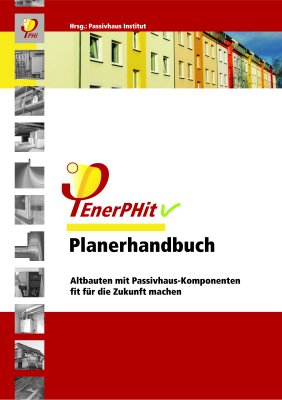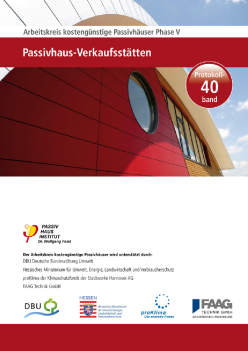New builds / residential buildings
- Peer-reviewed article:
"Are the energy savings of the passive house standard reliable? A review of the as-built thermal and space heating performance of passive house dwellings from 1990 to 2018"
The article deals in particular with the monitoring results of completely recorded settlements, which the Passive House Institute accompanied with careful research approaches. The core statement of the study is that the Passive House standard has been functioning as projected for many years and that there is no relevant 'performance gap' (gap between the expectation and the actual measured result).
Authors: David Johnston, Mark Siddall, Oliver Ottinger, Soeren Peper and Wolfgang Feist
The article is available for free reading.
- Peer-reviewed article:
"Durability of building fabric components and ventilation systems in passive houses" – Feist et al
- The Passive House standard can be applied to the whole range of residential, commercial, and special-use buildings, whether new builds or a retrofit. Thousands of Passive Houses have already been built for diverse purposes, in a variety of climate zones using different construction methods. The very first prototype was a terrace house with four residential units. It was built in Darmstadt between 1990/1991. This building, with typical masonry outer walls, concrete floor slabs, and a wooden green roof is a high-quality example of very energy-efficient construction. All relevant energy flows through the building envelope were accurately recorded over a period of more than 25 years. This data confirms that the energy consumption over the entire period is as consistently low as planned.
This article examines in detail how the construction method has affected the indoor climate, indoor air quality and the durability of all components. In-depth analyses evaluate the maintenance cycles representative for this type of building. The principal characteristics of the components and the ventilation system after 25 years of operation were determined. The results are groundbreaking for the Passive House concept: proving the construction method is not only effective in significantly reducing energy demand but above all, it is also highly durable and exceptionally low-maintenance.
Authors: Wolfgang Feist, Wolfgang Hasper, Passive House Institute, Rainer Pfluger, University of Innsbruck
The article is available for free reading.
- "Climate Neutral Passive House Estate in Hannover-
Kronsberg: Construction and Measurement Results"– A report detailing the design, construction, and monitoring results one of the first Passive House developments, Hannover-Kronsberg Passive Houses (Germany).
This publication is a combination of the CEPHEUS (Cost Efficient Passive Houses as European Standards) reports Nr. 18 and Nr. 19 . The Stadtwerke Hannover commissioned the combination in the framework of the European project
CEPHEUS (Cost Efficient Passive Houses as European Standards) reports Nr. 18 and Nr. 19 . The Stadtwerke Hannover commissioned the combination in the framework of the European project  Promotion of European Passive Houses (PEP) .
Promotion of European Passive Houses (PEP) .
Download ( pdf 4,54 MB)
pdf 4,54 MB)
- Climate-neutral Passive House estate in Hannover-Kronsberg, Germany (32 terraced houses), German only
Overview of contents - Multi-storey building in Hamburg Pinnasberg, Germany. (Special feature: 11 floors, study of the stairwell shaft), German only
Overview of contents - North-facing Passive House in Frankfurt (Grempstraße), Germany. (Special feature: comparison of energy use in south/north-facing buildings, distribution losses), German only
Overview of contents - Monitoring: Passive House with seasonal solar storage in the ground under the floor slab, German only
Overview of contents - Monitoring of Passive House city district of Bahnstadt Heidelberg
Download ( pdf 3.79 MB)
pdf 3.79 MB)
- Energy efficiency of the Passive House Standard: Expectations confirmed by measurements in practice - report 2015
Overview of contents
- Determination of the heat loss coefficient (HLC) of a Passive House - report 2016
Overview of contents
Further technical literature on this topic is available for purchase here.
| Next Courses |
PHPP Expert
Passive House Designer / Consultant
Construction Verifier
Site Supervisor
![]() read more
read more
e-learning
| Events |
iPHA Webinar | "Passivhaus policy and legislation in Scotland" | April 17, 2024
![]() read more
read more
![]() Passive House Open Days |
Passive House Open Days |
28 - 30 June 2024
![]() read more
read more
| Component Database |
 Passive House
Passive House
Component Database
read more
| Projects |
| New developments |
![]() designPH
designPH
read more
![]() NEW: PHPP 10 (2021)
NEW: PHPP 10 (2021)
read more
 Seals for Certified Passive House Components
Seals for Certified Passive House Components
read more
 Passive House Classes,
Passive House Classes,
Classic, Plus, Premium
read more
 EnerPHit -
EnerPHit -
PHI certification for retrofits
read more
 Wall plaque
Wall plaque
for certified Passive Houses
read more
| Press releases |
| Research & Literature |
![]() Passive Houses for different climate zones
Passive Houses for different climate zones
more
 Retrofits with Passive House components -
Retrofits with Passive House components -
EnerPHit Planner Handbook
(in German)
 Passive House Retail Stores now out
Passive House Retail Stores now out
Overview of contents
(in German)

